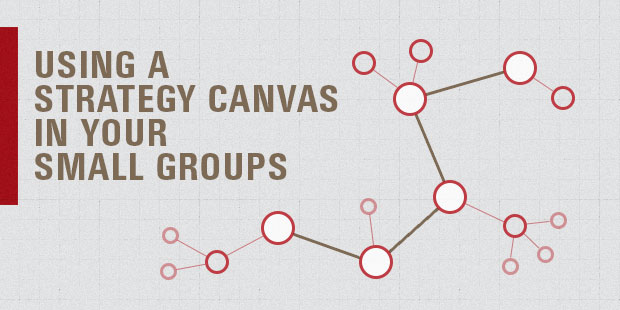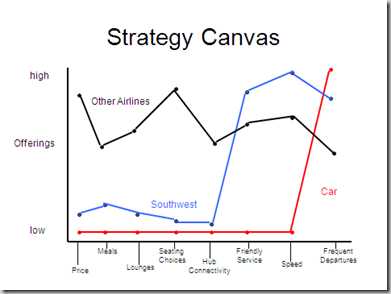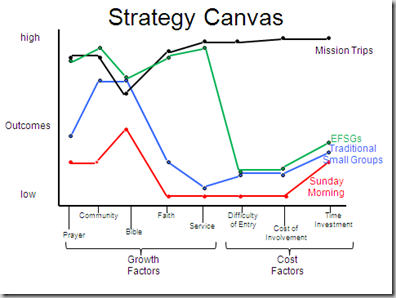
Using a Strategy Canvas in Your Small Groups
A couple of weeks ago we had the last session of our Externally Focused Small Groups (EFSGs) InnovationLab. Here are a few ideas behind the power of EFSGs:
1. Although good deeds create good will which often leads to good news, it is good friends who help turn good intentions into good deeds which create good will…. In other words people are more likely to do things they don’t even want to do with people they like being with than they are to ever discover that one place of service by themselves.
2. Service needs to be built into the charter of each small group…not just as a value but part of the structure. We have to create systems to operationalize our values or these are not values, they are merely sentiments. This is where the principles in “Change Anything” come in. In the book the authors talk about 3 levels of change:
- Personal motivation and ability—Everyone seems to have the “want-to” to make a difference in the world but most folks, by themselves, rarely do—maybe 5%
- Social motivation and ability—We become like the people (in habit and lifestyle) we hang out with. It’s called “regression to the mean.” So if everyone in the small group is serving, there is a good chance (50%) that you will be serving
- Structural motivation and ability—If every small group, by design, has service built into its structure, meaning, every 4-8 times that you meet, instead of meeting, you go serve together, this increases the odds to 95-100%
This is what our friends at Chase Oaks Church in Plano, Texas have discovered. Every small group has a leader and 3 other “champions” under that leader:
- A content champion—the person that is passionate about the Bible input
- A community champion—the person who takes responsibility for seeing that the needs inside the group are met—that people feel loved, heard and cared for
- A bridge champion—the person who leads the service between the small group and the organization they serve
Pastors Glenn Brechner and Jason Williams do a phenomenal job of giving folks the opportunity to live missionally.
Many of you have read the book “Blue Ocean Strategy.” One of the good take-aways for me was the idea of having a Strategy Canvas where one can do a comparison between the attributes of several enterprises. So for instance Southwest Airlines can compare itself to other airlines as well as an automobile. Points of comparison are price, meals, lounges, frequency of departure. By plotting out the offering of the three entities, one can conclude that Southwest has more in common with an automobile than with other airlines. Very interesting.
Now, how about EFSGs compared to other offerings the church has to help people grow—Sunday morning services, traditional small groups, and mission trips.
What can we conclude? That EFSGs are have the growth benefits / results that are more like a missions trip with the cost being similar to a worship service or regular small group.
So try out the strategy canvas on projects you are working on to discover the value of what you are doing.

Tags: Connect, Eric Swanson, Small Groups, Strategy













